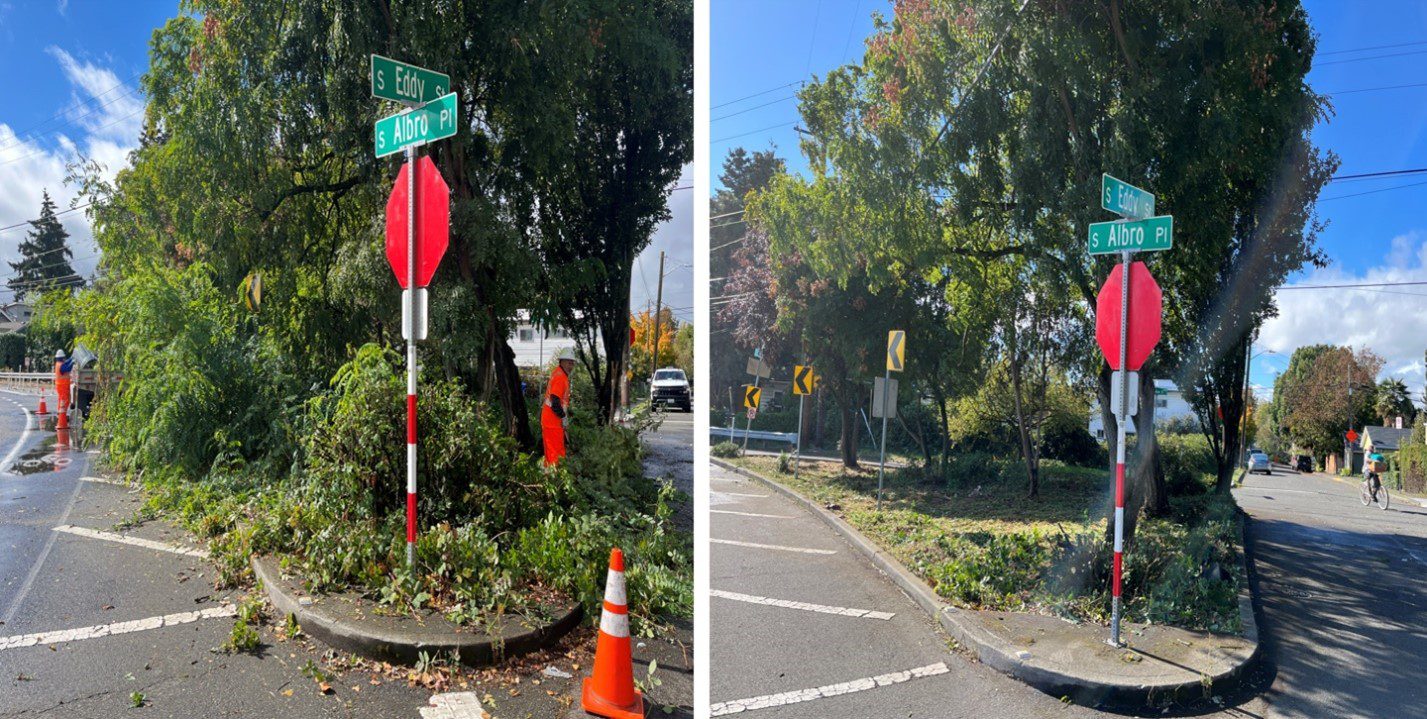 Before and after photos of vegetation cleared by SDOT crews at Airport Way S and S Lucile St in the Georgetown neighborhood. Photo: SDOT
Before and after photos of vegetation cleared by SDOT crews at Airport Way S and S Lucile St in the Georgetown neighborhood. Photo: SDOT Blog stats: 800 words | 4-minute read
The wet spring and mild summer made for excellent growing conditions for Seattle’s greenery and trees. This is great for the health of our green spaces and street trees, but it also creates challenges to keep this vegetation from interfering with our streets, signs, signals, sidewalks, trails, and bike lanes. This month, we geared up and made an extra push to address overgrown vegetation on major streets and areas throughout the city.
Our SDOT Urban Forestry crews maintain formally planted areas on major arterial streets and other public spaces around a variety of transportation infrastructure, such as a bridge or a public stairway. This month, our landscape crews partnered with our right-of-way maintenance, tree maintenance, paving, signs & markings, and Unified Care Team crews to perform an emphasis on vegetation management and clearing.
The most recent emphasis work took place between October 1-5. During this time, our crews cleared numerous areas where vegetation had begun to obstruct visibility. We expect to refine this collaboration between our many SDOT crew teams and repeat the clearing pilot effort as needed in the future.
Thank you to everyone who navigated the work areas while we placed temporary “No Parking” signs and traffic control devices to keep workers and the traveling public safe.
Check out several before-and-after photos below that show the scale of the vegetation we cleared, which included the following locations:
- Sand Point Way medians
- Highland Park Way SW
- Olson Pl SW planting strips
- Meyers Way S Exit (southbound)
- 2nd Ave SW
- SW Michigan St
- N 46th St & Aurora Ave N
- Martin Luther King Way S (S Alaska to S Othello streets)
- Eastlake Ave E medians
- Harvard Ave E & E Allison St medians
- Westlake landscapes N of Roy St
- S Lucile Street & Airport Way S
- West Seattle Bridge complex (near Chelan Ave SW)
- Emerson Bike Trail
- 14th Ave NW medians
- 5th Ave NE medians
- 15th Ave W & W Nickerson St landscape complex
- S Sullivan St & South Park Bridge
- Ellis Ave S & S Eddy St
- Beacon Ave S & S McClellan St
- Mercer St & Fairview Ave N/Roy St
- College Way N medians
Before and after photos







Who is responsible for cutting back weeds and overgrown vegetation?
The general rule is that the adjacent property owner is responsible. Private property owners are responsible for maintaining the sidewalks and planting strips next to their property; the Seattle Department of Transportation (SDOT) is responsible for street medians and certain other areas next to public property such as next to City bridges. The Seattle Department of Parks and Recreation maintains areas next to City parks.
Property owners are responsible for keeping vegetation from their property from blocking sidewalks or streets. To provide sufficient clearance for pedestrians, tree branches should hang no lower than 8 feet above the surface of a sidewalk. To provide enough clearance for vehicles including large trucks, branches should hang no lower than 14 feet above the surface of a street. It is also important to trim back vegetation that might block the view of an intersection from a distance of 30 feet, or vegetation that might obscure a traffic sign or traffic signal.
You can learn more about property owners’ responsibilities for cutting overgrown vegetation on sidewalks and planting strips in our recent blog post.
For more information about City regulations, see the Seattle Weeds & Vegetation Ordinance.